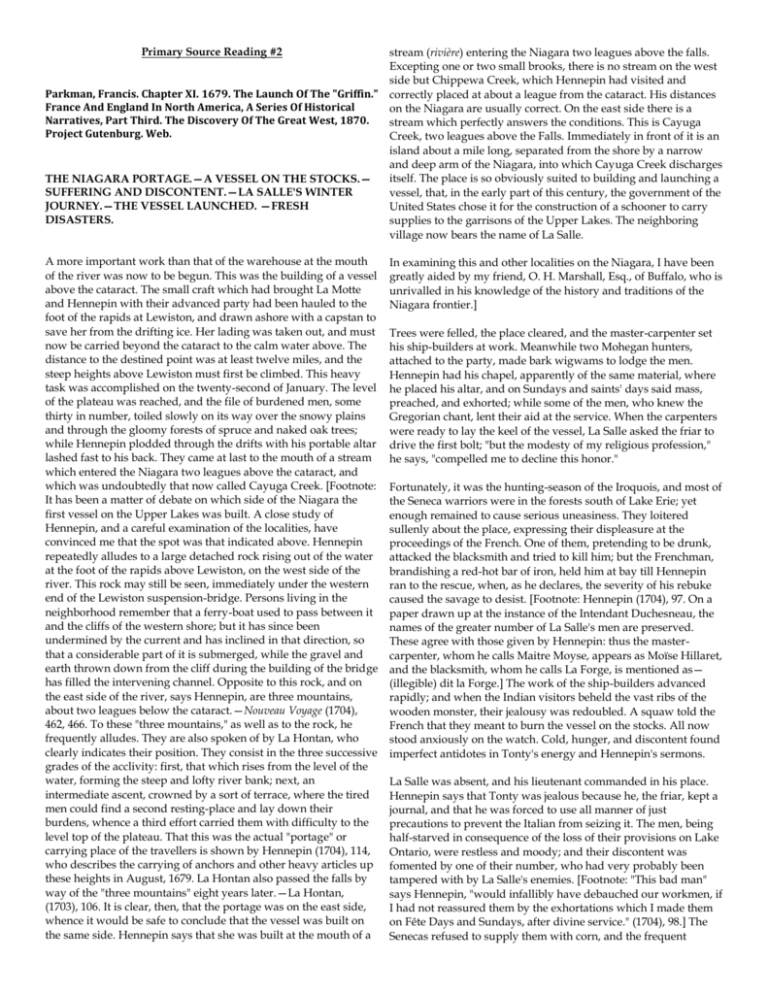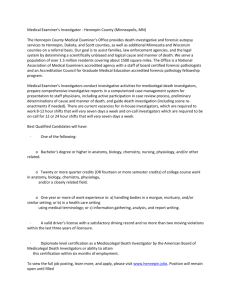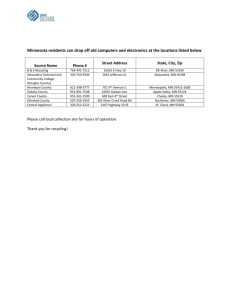Launch of The Griffen
advertisement

Primary Source Reading #2 stream (rivière) entering the Niagara two leagues above the falls. Excepting one or two small brooks, there is no stream on the west side but Chippewa Creek, which Hennepin had visited and Parkman, Francis. Chapter XI. 1679. The Launch Of The "Griffin." correctly placed at about a league from the cataract. His distances France And England In North America, A Series Of Historical on the Niagara are usually correct. On the east side there is a Narratives, Part Third. The Discovery Of The Great West, 1870. stream which perfectly answers the conditions. This is Cayuga Project Gutenburg. Web. Creek, two leagues above the Falls. Immediately in front of it is an island about a mile long, separated from the shore by a narrow and deep arm of the Niagara, into which Cayuga Creek discharges itself. The place is so obviously suited to building and launching a THE NIAGARA PORTAGE.—A VESSEL ON THE STOCKS.— SUFFERING AND DISCONTENT.—LA SALLE'S WINTER vessel, that, in the early part of this century, the government of the JOURNEY.—THE VESSEL LAUNCHED. —FRESH United States chose it for the construction of a schooner to carry DISASTERS. supplies to the garrisons of the Upper Lakes. The neighboring village now bears the name of La Salle. A more important work than that of the warehouse at the mouth of the river was now to be begun. This was the building of a vessel above the cataract. The small craft which had brought La Motte and Hennepin with their advanced party had been hauled to the foot of the rapids at Lewiston, and drawn ashore with a capstan to save her from the drifting ice. Her lading was taken out, and must now be carried beyond the cataract to the calm water above. The distance to the destined point was at least twelve miles, and the steep heights above Lewiston must first be climbed. This heavy task was accomplished on the twenty-second of January. The level of the plateau was reached, and the file of burdened men, some thirty in number, toiled slowly on its way over the snowy plains and through the gloomy forests of spruce and naked oak trees; while Hennepin plodded through the drifts with his portable altar lashed fast to his back. They came at last to the mouth of a stream which entered the Niagara two leagues above the cataract, and which was undoubtedly that now called Cayuga Creek. [Footnote: It has been a matter of debate on which side of the Niagara the first vessel on the Upper Lakes was built. A close study of Hennepin, and a careful examination of the localities, have convinced me that the spot was that indicated above. Hennepin repeatedly alludes to a large detached rock rising out of the water at the foot of the rapids above Lewiston, on the west side of the river. This rock may still be seen, immediately under the western end of the Lewiston suspension-bridge. Persons living in the neighborhood remember that a ferry-boat used to pass between it and the cliffs of the western shore; but it has since been undermined by the current and has inclined in that direction, so that a considerable part of it is submerged, while the gravel and earth thrown down from the cliff during the building of the bridge has filled the intervening channel. Opposite to this rock, and on the east side of the river, says Hennepin, are three mountains, about two leagues below the cataract.—Nouveau Voyage (1704), 462, 466. To these "three mountains," as well as to the rock, he frequently alludes. They are also spoken of by La Hontan, who clearly indicates their position. They consist in the three successive grades of the acclivity: first, that which rises from the level of the water, forming the steep and lofty river bank; next, an intermediate ascent, crowned by a sort of terrace, where the tired men could find a second resting-place and lay down their burdens, whence a third effort carried them with difficulty to the level top of the plateau. That this was the actual "portage" or carrying place of the travellers is shown by Hennepin (1704), 114, who describes the carrying of anchors and other heavy articles up these heights in August, 1679. La Hontan also passed the falls by way of the "three mountains" eight years later.—La Hontan, (1703), 106. It is clear, then, that the portage was on the east side, whence it would be safe to conclude that the vessel was built on the same side. Hennepin says that she was built at the mouth of a In examining this and other localities on the Niagara, I have been greatly aided by my friend, O. H. Marshall, Esq., of Buffalo, who is unrivalled in his knowledge of the history and traditions of the Niagara frontier.] Trees were felled, the place cleared, and the master-carpenter set his ship-builders at work. Meanwhile two Mohegan hunters, attached to the party, made bark wigwams to lodge the men. Hennepin had his chapel, apparently of the same material, where he placed his altar, and on Sundays and saints' days said mass, preached, and exhorted; while some of the men, who knew the Gregorian chant, lent their aid at the service. When the carpenters were ready to lay the keel of the vessel, La Salle asked the friar to drive the first bolt; "but the modesty of my religious profession," he says, "compelled me to decline this honor." Fortunately, it was the hunting-season of the Iroquois, and most of the Seneca warriors were in the forests south of Lake Erie; yet enough remained to cause serious uneasiness. They loitered sullenly about the place, expressing their displeasure at the proceedings of the French. One of them, pretending to be drunk, attacked the blacksmith and tried to kill him; but the Frenchman, brandishing a red-hot bar of iron, held him at bay till Hennepin ran to the rescue, when, as he declares, the severity of his rebuke caused the savage to desist. [Footnote: Hennepin (1704), 97. On a paper drawn up at the instance of the Intendant Duchesneau, the names of the greater number of La Salle's men are preserved. These agree with those given by Hennepin: thus the mastercarpenter, whom he calls Maitre Moyse, appears as Moïse Hillaret, and the blacksmith, whom he calls La Forge, is mentioned as— (illegible) dit la Forge.] The work of the ship-builders advanced rapidly; and when the Indian visitors beheld the vast ribs of the wooden monster, their jealousy was redoubled. A squaw told the French that they meant to burn the vessel on the stocks. All now stood anxiously on the watch. Cold, hunger, and discontent found imperfect antidotes in Tonty's energy and Hennepin's sermons. La Salle was absent, and his lieutenant commanded in his place. Hennepin says that Tonty was jealous because he, the friar, kept a journal, and that he was forced to use all manner of just precautions to prevent the Italian from seizing it. The men, being half-starved in consequence of the loss of their provisions on Lake Ontario, were restless and moody; and their discontent was fomented by one of their number, who had very probably been tampered with by La Salle's enemies. [Footnote: "This bad man" says Hennepin, "would infallibly have debauched our workmen, if I had not reassured them by the exhortations which I made them on Fête Days and Sundays, after divine service." (1704), 98.] The Senecas refused to supply them with corn, and the frequent exhortations of the Récollet father proved an insufficient substitute. In this extremity, the two Mohegans did excellent service; bringing deer and other game, which relieved the most pressing wants of the party and went far to restore their cheerfulness. La Salle, meanwhile, was making his way back on foot to Fort Frontenac, a distance of some two hundred and fifty miles, through the snow-encumbered forests of the Iroquois and over the ice of Lake Ontario. The wreck of his vessel made it necessary that fresh supplies should be sent to Niagara; and the condition of his affairs, embarrassed by the great expenses of the enterprise, demanded his presence at Fort Frontenac. Two men attended him, and a dog dragged his baggage on a sledge. For food, they had only a bag of parched corn, which failed them two days before they reached the fort; and they made the rest of the journey fasting. During his absence, Tonty finished the vessel, which was of about forty- five tons burden. [Footnote: Hennepin (1683), 46. In the edition of 1697, he says that it was of sixty tons. I prefer to follow the earlier and more trustworthy narrative.] As spring opened, she was ready for launching. The friar pronounced his blessing on her; the assembled company sang Te Deum; cannon were fired; and French and Indians, warmed alike by a generous gift of brandy, shouted and yelped in chorus as she glided into the Niagara. Her builders towed her out and anchored her in the stream, safe at last from incendiary hands, and then, swinging their hammocks under her deck, slept in peace, beyond reach of the tomahawk. The Indians gazed on her with amazement. Five small cannon looked out from her portholes; and on her prow was carved a portentous monster, the Griffin, whose name she bore, in honor of the armorial bearings of Frontenac. La Salle had often been heard to say that he would make the griffin fly above the crows, or, in other words, make Frontenac triumph over the Jesuits. They now took her up the river, and made her fast below the swift current at Black Rock. Here they finished her equipment, and waited for La Salle's return; but the absent commander did not appear. The spring and more than half of the summer had passed before they saw him again. At length, early in August, he arrived at the mouth of the Niagara, bringing three more friars; for, though no friend of the Jesuits, he was zealous for the Faith, and was rarely without a missionary in his journeyings. Like Hennepin, the three friars were all Flemings. One of them, Melithon Watteau, was to remain at Niagara; the others, Zenobe Membré and Gabriel Ribourde, were to preach the Faith among the tribes of the West. Ribourde was a hale and cheerful old man of sixty-four. He went four times up and down the Lewiston heights, while the men were climbing the steep pathway with their loads. It required four of them, well stimulated with brandy, to carry up the principal anchor destined for the "Griffin." La Salle brought a tale of disaster. His enemies, bent on ruining the enterprise, had given out that he was embarked on a harebrained venture, from which he would never return. His creditors, excited by rumors set afloat to that end, had seized on all his property in the settled parts of Canada, though his seigniory of Fort Frontenac alone would have more than sufficed to pay all his debts. There was no remedy. To defer the enterprise would have been to give his adversaries the triumph that they sought; and he hardened himself against the blow with his usual stoicism.






